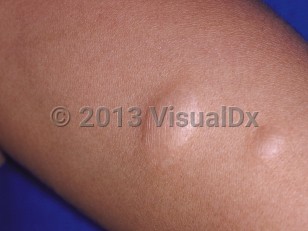Anetoderma in Child
Alerts and Notices
Important News & Links
Synopsis

Anetoderma may be primary or secondary. Primary anetoderma occurs when there is no underlying skin disorder. Cardiac, ocular, bony, pulmonary, and endocrine abnormalities have been reported to occur in some patients with primary anetoderma.
The lesions of secondary anetoderma are identical to those of primary anetoderma but appear at the same sites as a preceding dermatosis. A multitude of conditions are associated with the development of secondary anetoderma. These include varicella, folliculitis, acne vulgaris, lichen planus, syphilis, granuloma annulare, tuberculosis, human immunodeficiency virus (HIV), pyoderma gangrenosum, Steven-Johnson syndrome, B-cell lymphoma, juvenile xanthogranuloma, melanocytic nevi, sarcoidosis, dermatofibromas, prurigo nodularis, lupus erythematosus, leprosy, mastocytosis, plasmacytomas, xanthomas, lymphocytoma cutis, acrodermatitis chronica atrophicans, pilomatricoma, antiphospholipid antibody syndrome, penicillamine, nodular amyloidosis, and hepatitis B immunization.
Anetoderma has also been described in premature neonates (see Anetoderma of prematurity). Rare reports of familial anetoderma have also been documented.
Codes
L90.1 – Anetoderma of Schweninger-Buzzi
L90.2 – Anetoderma of Jadassohn-Pellizzari
SNOMEDCT:
238828009 – Anetoderma
Look For
Subscription Required
Diagnostic Pearls
Subscription Required
Differential Diagnosis & Pitfalls

Subscription Required
Best Tests
Subscription Required
Management Pearls
Subscription Required
Therapy
Subscription Required
Drug Reaction Data
Subscription Required
References
Subscription Required
Last Updated:04/19/2018

